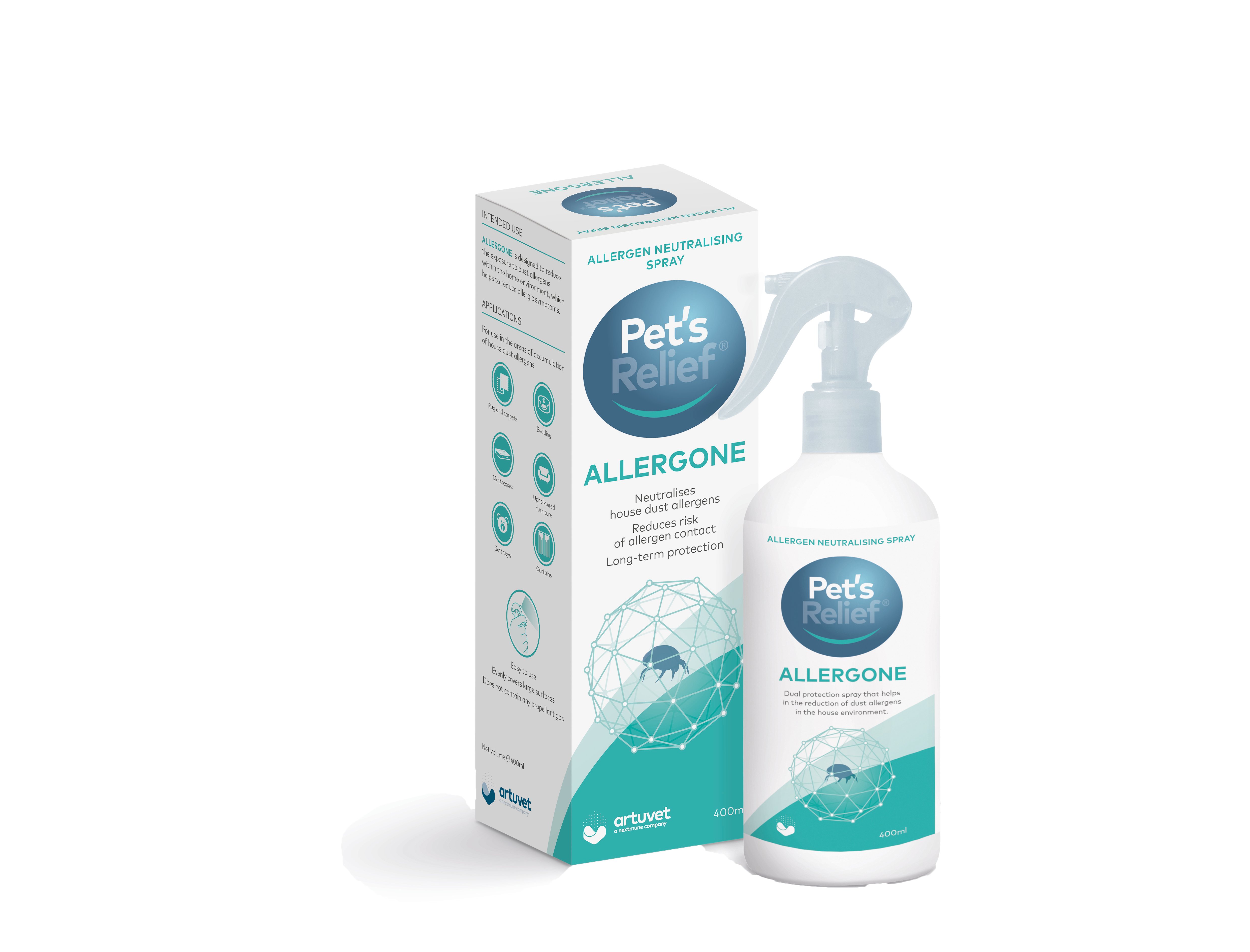As our PAX proposition keeps on expanding, we are happy to further accommodate you with an FAQ about PAX. This way, you will get the most out of our new method for allergy testing.
What is molecular allergology?
Molecular allergology is a state-of-the-art approach to the detection of sensitisations, whereby defined single allergen components are used for the determination of specific IgE in place of traditionally used allergen extracts. The molecular components are purified or recombinant proteins that provide a higher level of standardisation than allergen extracts and enable a more precise identification of IgE sensitisations. In the last decade, molecular allergology tests for humans have been powerful tools that help pinpoint allergy triggers, thus facilitating risk assessment and therapy decisions.
What is the PAX?
The PAX (Pet Allergy Xplorer) is the first commercial veterinary multiplex macroarray quantitative IgE serological assay. It will use cartridges with between 250 and 300 spots containing both extracts (one-third) and molecular components (i.e., individual allergens, two-thirds).

How were allergens selected for the PAX?
The PAX is derived from the ALEX2 used for humans. We first eliminated all extracts and components (i.e., the molecular allergens) that were deemed to be irrelevant for pets (for example, those of kiwi, shrimp, peach, etc…). As the ALEX2 contains few extracts, we then added those that were known to be important for dogs, for example those for the Dermatophagoides farinae house dust mite and the Tyrophagus putrescentiae storage mite.
As there are unique characteristics that make a protein an allergen, we then kept all components from the ALEX2 that would be likely targeted by animal IgE.
Finally, we added all components known to be allergens for animals, which were absent from the ALEX2 for humans. After testing more than 1,000 canine sera from Europe, we could see that nearly all extracts and components had yielded positive specific IgE detection in a varying proportion of dogs, thus confirming that the approach for allergen selection was valid. Nextmune will adjust the nature of extracts and components present on the cartridge over time, so that allergens that are non or poorly reactive will be removed. On the other hand, Nextmune scientists will be working to characterize the “allergome” of dogs, cats and horses, so that important new components are regularly added to the cartridges.
Is there any interference from icterus, lipemia and hemolysis?
One serum sample containing allergen-specific IgE at different concentrations was spiked with either bilirubin, triglycerides or hemoglobin at the concentrations of 2.5, 150 and 15 mg/dL, respectively. All specific IgE values were within 25% of those of the serum without spiking, and the average ratio of the spiked serum over that without it varied between 96 and 100%.
Bottomline: there is no relevant influence of icterus, lipemia or hemolysis on the PAX results.
What are CCDs and where are they found?
Most allergens are glycoproteins, meaning that some amino acids have a carbohydrate (sugar) chain. The allergens from plants (including plant foods), insect (bee) venoms and nematodes (worms) have carbohydrate chains that are different from those of mammals. As a result, these chains can be recognized by IgE from humans and animals. Unfortunately, as the sugars are shared among allergens, they can elicit cross-reactivities, which is why they are called CCDs, or cross-reactive carbohydrate determinants.

How are CCDs involved in allergy?
During an allergic reaction, IgE is produced against the carbohydrate chains as well as the allergen’s proteins. Studies have confirmed that this occurs in 30% of humans, dogs and cats. The IgE against CCD chains does not seem to be clinically relevant.
Why is it important to block CCDs?
Blocking CCDs means that the specificity of the serological test is enhanced. Evidence shows that the correlation with intradermal testing results is also improved.
Are cross-reactive carbohydrate determinants (CCD) blocked in PAX?
Each animal serum tested is diluted in a buffer that contains a proprietary mix of proteins that contain different types of CCDs. The PAX is also the first veterinary serological test that has incorporated CCD detectors on each cartridge to verify the efficiency of the CCD blocking.
Which anti-IgE reagent is used in the PAX?
For the canine test, the PAX uses the anti-dog IgE monoclonal 5.91, which was produced in the 1990’s by Prof. Bruce Hammerberg at the NC State University College of Veterinary Medicine. This antibody recognizes an epitope in the Ce2 segment of the Fc-fragment of canine IgE. The epitope is distinct from the IgE regions that bind to the high- and low-affinity IgE receptors, thus ensuring that there is no interference from the soluble IgE receptors that are naturally present in allergic dogs. Of importance is that the sequence of the epitope recognized on dog IgE is completely different from that present on canine IgM, IgA and the four different IgG subclasses (IgG1 to IgG4). In fact, we verified, using both standard ELISA and the PAX that the 5.91 antibody does not bind to canine IgG.
Work is ongoing to identify the best antibody against feline and equine IgE for their inclusion in the PAX.
Bottomline: the 5.91 monoclonal anti-IgE is uniquely specific for dog IgE. A different antibody will be used for cats and horses.
What is the precision of the assay?
The precision was determined in two different conditions:
For the cartridge lot-to-lot variation, two different lots were compared using 54 allergen/sample combinations covering 44 allergens. For the specific IgE values lower than 400 ng/mL, the intra-assay coefficient of variation was 3.0% and the inter-assay coefficient was 7.1%. For the values above 400 ng/mL, these CV% were 2.0 and 5.2%, respectively.
For the determination of the repeatability, three canine serum samples were tested in duplicates in five different runs. As above, for the lower IgE values, the intra- and inter-assay CV% were 6.2 and 8.2%, respectively; those for the higher values were 2.7 and 7.0%, respectively.
Bottomline: The precision of the PAX is excellent with results being highly reproducible.
Why are there more negative results when I send canine sera tested with the PAX compared to other older technologies?
To better answer this question, let’s look at the PAX results collected so far in 2023 from more than 25,000 dogs.
In Europe (11,196 sera), the percentages of dogs with at least one positive varied depending on the testing laboratory (Spain, Netherlands, and the UK) and the month of testing between 83% (Spain, April) and 96% (UK, June). If one were only to consider the percentage of dogs that would be candidates for immunotherapy (that is, excluding food allergens, insect venoms, and flea saliva allergen Cte f 1), the percentages would vary between 51% (UK, April) and 88% (UK, June; NL, April).
In the US, the percentage among 14,243 dogs with at least one detectable specific IgE with the PAX has remained fairly stable for most of the winter and spring (84-87%) to increase in July (88%) and August (95%). Among these, the percentage of dogs potentially treatable by immunotherapy varied from a low of 70% in January, increasing each month to reach 91% in August.
While some veterinarians might occasionally receive a string of negative tests, this is not a widespread situation, as the numbers above are well within the range of what would be expected from the literature. One must remember that some dogs have atopic dermatitis (AD) look-alike pruritic conditions that are not allergic, while others have AD with a lesion mechanism that is likely not involving IgE. Indeed, the so-called “atopic-like dermatitis” represented about 15% of dogs with a lesion distribution and pruritus typical of AD but negative intradermal and serological tests in a recent study (Botoni, Vet Dermatol 2019).
Why is there such a variation?
The answer is simple: these differences are due to variable seasonal pollen exposure. Let's look at the US, for which we have PAX data since January 2023. In the winter, the seropositivity rate to at least one pollen was around 40%. This rate varied between 48 and 64% in the spring, and in the summer, it climbed to 86% in August. Similarly, there was a steady increase in the number of allergens that could be included in the immunotherapy: about 4 in the winter, 5 in the spring, and 10 in August.
In Europe, we have had identical ebbs and flows of positivities to pollen allergens. For example, in a Dutch laboratory, the positivity rate to Fag s 1, the PR-10 allergen from Fagus sylvatica (common beech), was 57% in March, 45% in April, dropping to around 10-15% after that. In contrast, and due to a later pollination time, the peak of sensitisation to Fag s 1 in the UK was in May to drop slowly after that. Similarly and as expected, the sensitisation to grass pollens was highest in July in the Netherlands and the UK laboratory. Not only do we have to think of the season of pollination, but meteorological factors are likely also to influence the release of pollen. A great example is what was seen in the Spanish PAX laboratory, which tests principally sera from dogs living in Mediterranean countries and France. This summer, the level of IgE seropositivity to grass and weed pollens has been markedly lower than what was expected, likely due to the heat wave plaguing that part of Europe in July and August.
Why were such fluctuations not observed before?
There seems to be only one paper (Bjelland, Acta Vet Scand 2014) that documented such a variation. In Norwegian dogs tested with Heska’s Allercept test, the rate of seropositivity to allergens was higher in the summer and autumn (about 87%) than in the winter and spring (79%). The seasonal difference was greater for pollen allergens, with a low sensitisation rate of 39% in the winter and 50% in the summer.
There are some serological tests where this seasonal difference might not be apparent. The main explanation for this lies in the likely insufficient blocking of IgE that recognises plant allergen-bound cross-reactive carbohydrates (i.e., “CCD-IgE”), thus leading to false positive test results. While most laboratories now include CCD IgE blocking steps, Nextmune’s PAX is the only one that detects the efficiency of such blocking. If the first block is found insufficient, a second block is done, which might completely negativise the reactivity to pollen extracts. Furthermore, almost all pollen allergen components in the PAX are recombinant proteins devoid of CCDs.
To summarise, the positivity rate of the PAX is similar to that of other test results reported previously, but there is a strong influence of the season of testing in the overall sensitisation rate and that of pollens. Moreover, a unique CCD blocking strategy likely eliminates CCD-IgE, which could result in false positive IgE reactivity to pollen and plant food allergens in other serological tests.
What to do to limit negative PAX results?
Here is our recommended strategy:
1. Submit serum a month or so after the beginning of the season, to which the dog is known to exhibit flares and
2. Test when the dog is well into a flare so that the T cells have the time to turn on the IgE secretion by B cells.
Finally, remember that you might have dogs with atopic-like dermatitis in which skin and serum sensitisation tests will be negative.
 UK
UK

 Danmark
Danmark
 Deutschland
Deutschland
 Global English
Global English
 España
España
 Suomi
Suomi
 France
France
 Bélgique (FR)
Bélgique (FR)
 Italia
Italia
 Nederland
Nederland
 Norge
Norge
 Sverige
Sverige




